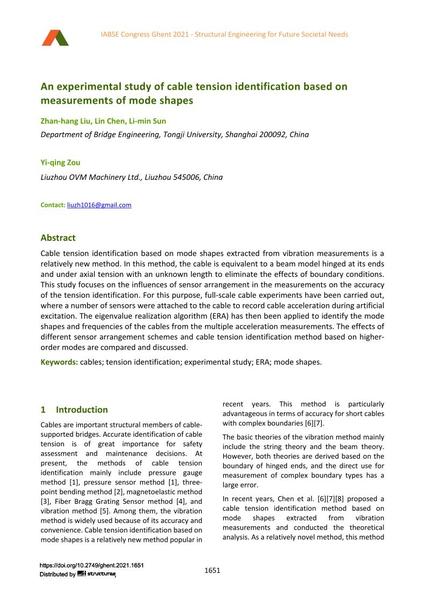An experimental study of cable tension identification based on measurements of mode shapes

|
|
|||||||||||
Bibliografische Angaben
| Autor(en): |
Zhan-hang Liu
(Department of Bridge Engineering, Tongji University, Shanghai 200092, China)
Lin Chen Li-Min Sun (Department of Bridge Engineering, Tongji University, Shanghai 200092, China) Yi-qing Zou (Liuzhou OVM Machinery Ltd., Liuzhou 545006, China) |
||||
|---|---|---|---|---|---|
| Medium: | Tagungsbeitrag | ||||
| Sprache(n): | Englisch | ||||
| Tagung: | IABSE Congress: Structural Engineering for Future Societal Needs, Ghent, Belgium, 22-24 September 2021 | ||||
| Veröffentlicht in: | IABSE Congress Ghent 2021 | ||||
|
|||||
| Seite(n): | 1651-1657 | ||||
| Anzahl der Seiten (im PDF): | 7 | ||||
| DOI: | 10.2749/ghent.2021.1651 | ||||
| Abstrakt: |
Cable tension identification based on mode shapes extracted from vibration measurements is a relatively new method. In this method, the cable is equivalent to a beam model hinged at its ends and under axial tension with an unknown length to eliminate the effects of boundary conditions. This study focuses on the influences of sensor arrangement in the measurements on the accuracy of the tension identification. For this purpose, full-scale cable experiments have been carried out, where a number of sensors were attached to the cable to record cable acceleration during artificial excitation. The eigenvalue realization algorithm (ERA) has then been applied to identify the mode shapes and frequencies of the cables from the multiple acceleration measurements. The effects of different sensor arrangement schemes and cable tension identification method based on higher- order modes are compared and discussed. |
||||
| Stichwörter: |
Seile
|
||||
| Copyright: | © 2021 International Association for Bridge and Structural Engineering (IABSE) | ||||
| Lizenz: | Die Urheberrechte (Copyright) für dieses Werk sind rechtlich geschützt. Es darf nicht ohne die Zustimmung des Autors/der Autorin oder Rechteinhabers/-in weiter benutzt werden. |
||||
